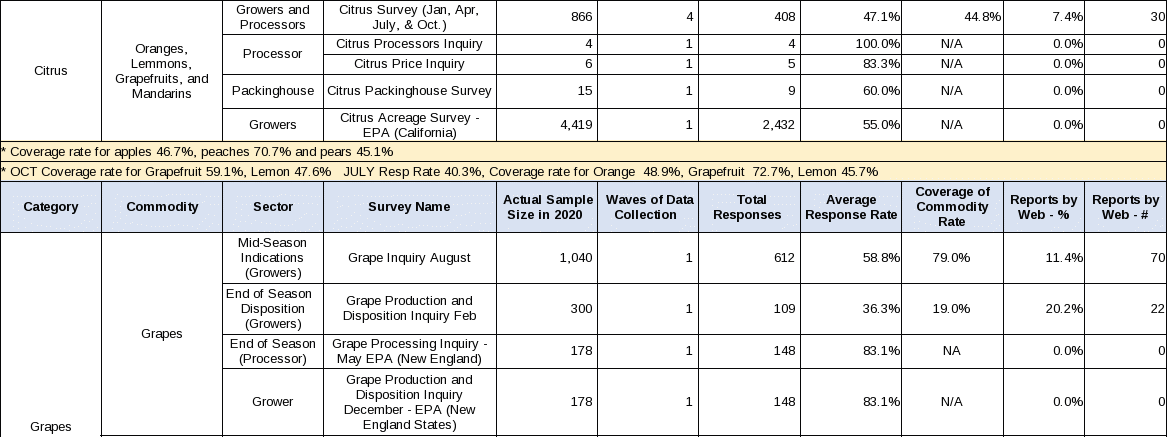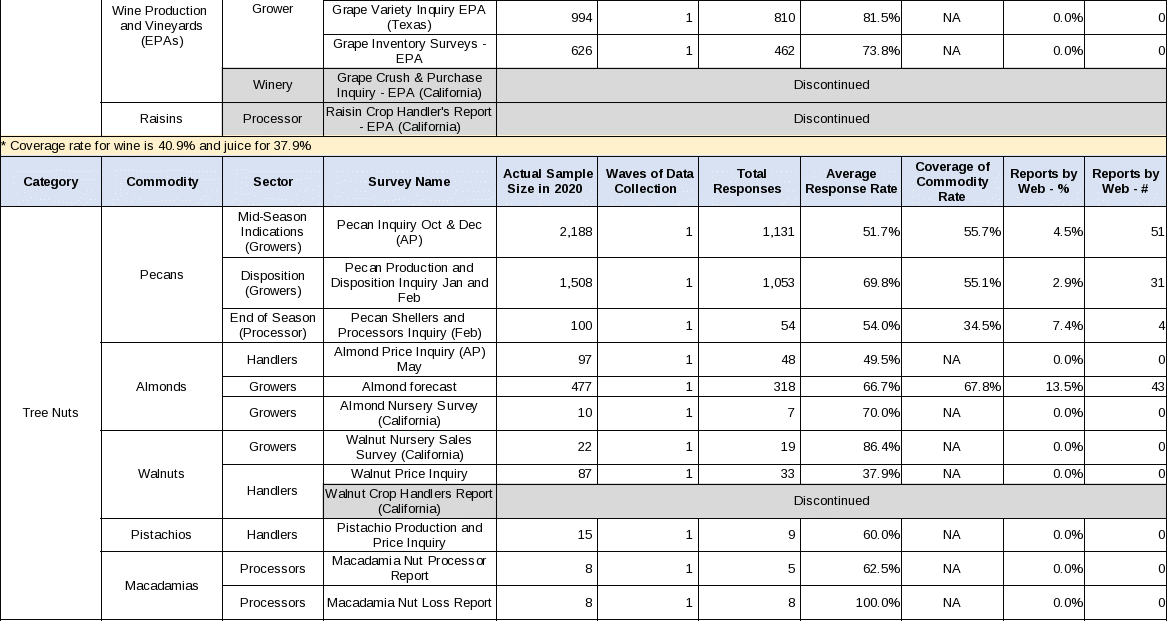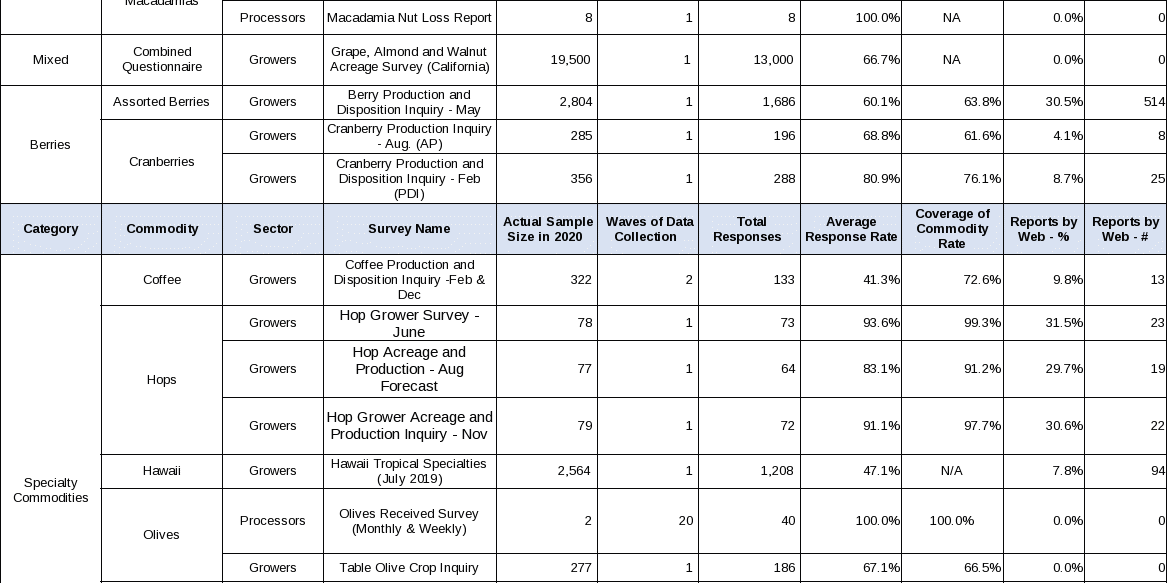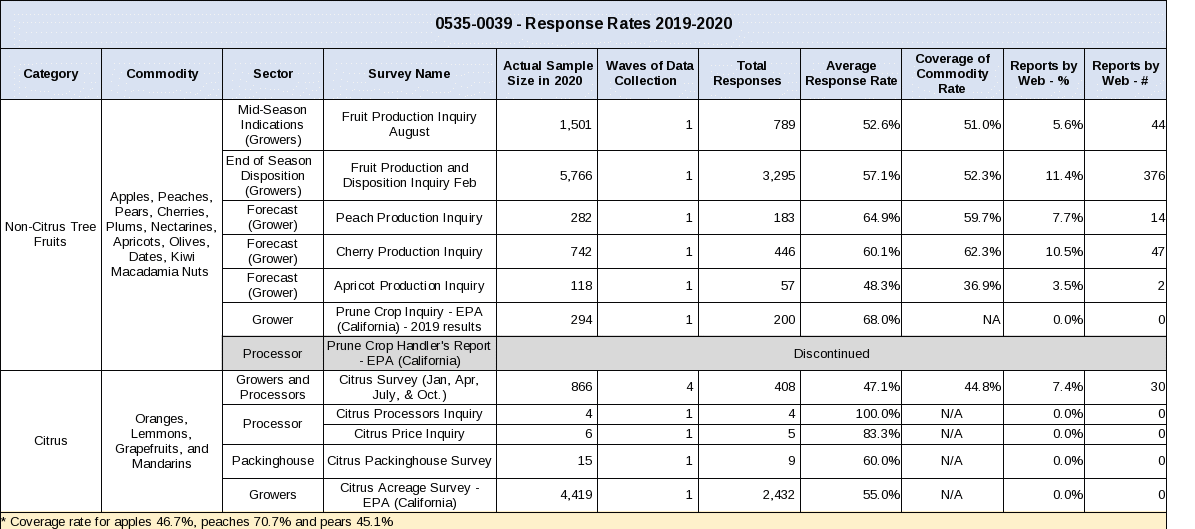0039-fruitnut-2020-SSB
0039-fruitnut-2020-SSB.docx
Fruit, Nuts, and Specialty Crops
OMB: 0535-0039
1 Supporting Statement - Part B
FRUIT, NUTS, AND SPECIALTY CROPS
OMB No. 0535-0039
B. COLLECTION OF INFORMATION EMPLOYING STATISTICAL METHODS
1. Describe (including a numerical estimate) the potential respondent universe and any sampling or other respondent selection method to be used. Data on the number of entities (e.g., establishments, State and local government units, households, or persons) in the universe covered by the collection and in the corresponding sample are to be provided in tabular form for the universe as a whole and for each of the strata in the proposed sample. Indicate expected response rates for the collection as a whole. If the collection has been conducted previously, include the actual response rate achieved during the last collection.
According to the 2017 Census of Agriculture, there were over 135,000 farm operators producing fruits, nuts and/or specialty crops in the United States. This is up slightly from the 2012 Census of Agriculture. During the first part of each year, NASS updates its List Frame with farmer reported survey data. Every five years NASS also updates its List Frame with farmer reported Census of Agriculture data. Every five years, NASS’s Statistics Division uses Census of Agriculture data to review and update targeted commodities and program states for each Survey Program. Results of this review can be found at:
Citrus
https://www.nass.usda.gov/Surveys/Program_Review/2019/Citrus-Program.pdf
Non-citrus Fruit and Tree Nuts
https://www.nass.usda.gov/Surveys/Program_Review/2019/Noncitrus-Fruit-and-Tree-Nut-Program.pdf
Mushrooms
https://www.nass.usda.gov/Surveys/Program_Review/2019/Mushroom%20Program.pdf
Complete enumerations of some fruit, nut, and specialty crop buyers, handlers, processors, shellers, and shippers (depending on the crop) are conducted because of the small number of firms involved and the significant differences in kind and quantity of product handled. Complete enumerations are also attempted of growers for several of the specialty crops such as hops and commercial mushroom growers.
Phone and field follow-up contacts for non-respondents are primarily directed at the larger producers. This helps to insure a high level of coverage for each commodity while reducing data collection costs.
Some crops such as pomegranates could be added to the surveys in the future if additional funding can be obtained.
NASS calculated response rates for data collections using the OMB standard response rate method. This method removes entities found to be out of scope for the given survey (ineligible) at the time of contact from the numerator and denominator.
Following the Terms of Clearance NASS received on the Field Crops docket (0535-0002) in Feb. 2013 NASS has been developing a procedure for calculating a weighted response rate (that is, a response rate weighted by contribution of the establishment to the industry of interest, or coverage) for surveys not obtaining an 80% response rate. Some of the surveys included in this docket are still administered by the individual Regional or State Field Offices. NASS is in the process of standardizing these surveys and moving them into a centralized environment so that we will be able to calculate both a weighted and un-weighted response rate for each of the surveys.
The achieved contact rates for each of the surveys conducted in 2019 and 2020 are in the following table. NASS will continue to strive to achieve a minimum of 80% response rate and/or a 70% weighted response rate on future surveys.



NASS Methodology Division, and Research and Development Division have conducted a Fruit and Nut Production and Disposition Inquiry Bias Analysis. This report is attached to this submission as a supplemental document.
2. Describe the procedures for the collection of information including:
• statistical methodology for stratification and sample selection,
• estimation procedure,
• degree of accuracy needed for the purpose described in the justification,
• unusual problems requiring specialized sampling procedures
Overview
– As with all NASS surveys, the goal is to collect data from at
least 80% of the records sampled and more importantly, achieve a
weighted unit response rate of at least 70% of the production data or
production area. We utilize mail, phone, internet and personal
interviews to collect data. In our ongoing effort to collect quality
data in a timely and economic manner, NASS utilizes the mail and/or
internet as the first method of data collection with selected phone
or personal interview follow up for non-response. With limited funds
for extensive data collection, phone and field enumeration is
targeted for the larger operations that will help achieve the 70%
weighted response rate.
Low Response Rates - With surveys that have persistently low response rates, NASS looks for alternative ways of collecting the data; particularly sources of administrative data. In instances where these data provide sufficient coverage and accuracy, we consider the opportunity to discontinue collections and reduce respondent burden.
Sampling NASS employs several different survey designs for its Fruit, Nut and Specialty Crops programs: Census, Simple Random sample (SRS), Stratified SRS, Probability Proportionate to Size (PPS) and Multivariate PPS (MPPS). For example, because of the relatively small number of entities on the Mushroom sampling frame, all of the entities are sampled; stratified SRS design is utilized for the Berry and Coffee Surveys; MPPS design is used for Grapes, Citrus and Non Citrus Tree Fruit Surveys.
The targeted crop control values are used as a measure of size to derive strata boundaries for surveys using the stratified SRS design. Strata boundaries are determined by reviewing the measure of size distribution or by assigning equal cumulative percentages of the measure of size to each strata.
Sample size determinations were derived using one or more of the following sampling methodologies: sample size formula that incorporated sampling frame or survey statistics and a target coefficient of variation value, percent coverage, ratio allocation or simulations.
3. Describe methods to maximize response rates and to deal with issues of non-response. The accuracy and reliability of information collected must be shown to be adequate for intended uses. For collections based on sampling, a special justification must be provided for any collection that will not yield "reliable" data that can be generalized to the universe studied.
Regional Office staff routinely visit producers and industry organizations to promote the programs and importance of cooperating. NASS maintains a presence at National industry meetings, often setting up promotional booths at trade shows. Occasionally, letters of endorsement are obtained from industry leaders. Most States conduct a full non-response follow up.
Some of the specialty surveys may have only a few respondents who account for a majority of the data for that given commodity. State and Regional Field Offices, in their efforts to reduce respondent burden as well as reduce the costs of data collection will concentrate their data collection efforts on the major producers for each of the commodities. Questionnaires are mailed out to the smaller respondents with minimal follow up. The information received in the mail is used to update control data as well as help States to establish the number of growers for each of the commodities. However, in most cases the total production, prices, area in production, etc. are estimated from data received from the larger operations. More importantly than getting the 80% good response rate for each survey, States strive to get greater than 80% coverage of data for all surveys.
NASS made numerous improvements to our internet data collection instrument for the 2017 Census of Agriculture to make it more user friendly. NASS is continuing to incorporate some of these improvements into all of our other surveys. Improving the Computer Assisted Web Interview (CAWI) tools will give farm operators the flexibility to respond whenever it is convenient for them and should result in higher response rates in the future.
In addition to the increased availability of the CAWI system NASS relies on multiple modes for collecting data. The questionnaires are mailed to the respondents who can either return them by postage paid envelope, email, fax, or telephone. If we have not received a response within the allotted time, phone and field enumerators will be used to contact the respondents. In order to keep costs to a minimum, NASS will concentrate the face to face and phone interviews on the larger operations.
4. Describe any tests of procedures or methods to be undertaken.
All data collections follow standardized procedures to ensure accurate estimates. Check data are available for most of the crops after the marketing season ends.
5. Provide the name and telephone number of individuals consulted on statistical aspects of the design and the name of the agency unit, contractor(s), grantee(s), or other person(s) who will actually collect and/or analyze the information for the agency.
Survey sample sizes are determined by the Sampling and Frame Development Section and reviewed and approved by NASS Survey Teams. The Agency's Sampling, Editing and Imputation Methodology Branch, Methods Division; Branch Chief is Mark Apodaca (202) 690-8141.
Data collection is carried out by NASS Regional Field Offices; Eastern Field Operation’s Director is Jody McDaniel, (202) 720-3638 and the Western Field Operation’s Director is Troy Joshua (202) 720-8220.
The NASS survey administrators in Headquarters for the Fruit, Nut and Specialty Surveys are in the Commodity Surveys Section of the Survey Administration Branch, Census and Survey Division; Branch Chief is Gerald Tillman, (202)720-3895. The survey administrators are responsible for coordination of sampling, questionnaires, data collection, training, Interviewer’s Manuals, Survey Administration Manuals, data processing, and other Regional Office support.
Estimates are compiled and reviewed by the Agency’s Statistics Division, Crops Branch; Branch Chief is Lance Honig, (202)720-3896.
Survey data are collected, reviewed, and summarized by the Regional Field Offices. Publications are released from the Regional Offices and Headquarters.
Survey design and methodology are determined by the Summary, Estimation, and Disclosure Methodology Branch, Methods Division; Branch Chief is Jeff Bailey, (202) 690-8141.
November 2020
| File Type | application/vnd.openxmlformats-officedocument.wordprocessingml.document |
| Author | David Hancock |
| File Modified | 0000-00-00 |
| File Created | 2022-05-12 |
© 2025 OMB.report | Privacy Policy
